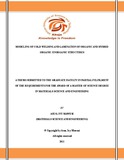| dc.contributor.author | Asuo, Ivy | |
| dc.date.accessioned | 2016-06-13T11:34:36Z | |
| dc.date.available | 2016-06-13T11:34:36Z | |
| dc.date.issued | 2011-12-15 | |
| dc.identifier.uri | http://repository.aust.edu.ng/xmlui/handle/123456789/414 | |
| dc.identifier.uri | http://library.aust.edu.ng:8080/xmlui/handle/123456789/414 | |
| dc.description.abstract | This research work presents the results of analytical studies of effects of pressure and adhesion energy on the interfacial properties of cold welded and laminated surfaces in organic and Hybrid Organic/Inorganic electronic structures. The analytical modeling is based on the physics of elastic behaviour of a cantilever beam. The energy balance approach was employed to model the surface contacts in Hybrid Organic/Inorganic structures, HOISOLs, and Organic Light Emitting Diodes, OLEDs. The results show that pressure can be used to alter the morphology and adhesive energies of cold-welded and laminated organic and hybrid electronic devices. This model also provides new insights into how the presence of Titanium dioxide nanoparticles affects the adhesion and contact profile of layered HOISOLs electronic structures. | en_US |
| dc.language.iso | en | en_US |
| dc.subject | Asuo Ivy | en_US |
| dc.subject | 2011 Materials Science and Engineering | en_US |
| dc.subject | Prof Wole Soboyejo | en_US |
| dc.subject | Organic and Hybrid Organic /INORGANIC Structures | en_US |
| dc.subject | Cold Welding | en_US |
| dc.subject | Modeling | en_US |
| dc.subject | Lamination | en_US |
| dc.title | Modeling of Cold Welding and Lamination of Organic and Hybrid Organic /INORGANIC Structures | en_US |
| dc.type | Thesis | en_US |

